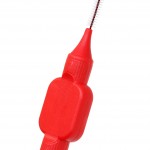
Good oral hygiene to ensure the effective removal of dental plaque is key to maintaining good oral health. While toothbrushing is the most commonly used method, dental floss and interdental brushes are both widely available and recommended adjuncts to toothbrushing. A 2011 Cochrane review by Sambunjak et al assessed the evidence for dental floss (Dental Elf 12th Dec 2011) and this new review considers the effects of interdental brushing in addition to toothbrushing, as compared with toothbrushing alone or toothbrushing and flossing for the prevention and control of periodontal diseases, dental plaque and dental caries.
The usual robust Cochrane methodological approaches were taken and a wide selection of databases were searched [Cochrane Oral Health Group’s Trials Register, the Cochrane Central Register of Controlled Trials (CENTRAL), Medline, Embase, CINAHL), LILACS, ZETOC Conference Proceedings and the Web of Science Conference Proceedings, US National Institutes of Health Trials Register and the metaRegister of Controlled Trials] with no restrictions on the language or date of publication.
Randomised controlled trials (including split-mouth design, cross-over and cluster-randomised trials) in dentate adults that compared toothbrushing and any interdental brushing procedure compared with toothbrushing only or toothbrushing and flossing were included.
- 7 studies involving a total of 354 patients were included. Only one study was at low risk of bias, 3 at high risk and 3 at unclear risk.
- The included studies only reported on plaque and gingivitis as outcome measures.
- Only one study (at high risk of bias) assessed interdental brushing in addition to toothbrushing, as compared with toothbrushing alone. This provides very low-quality evidence for a reduction in gingivitis (0 to 4 scale, mean in control): mean difference (MD) 0.53 (95% CI 0.23 to 0.83) and plaque (0 to 5 scale): MD 0.95 (95% CI 0.56 to 1.34) at one month, favouring of use of interdental brushes – representing a 34% reduction in gingivitis and a 32% reduction in plaque.
- 7 studies (326 participants) provided data for Interdental brushing in addition to toothbrushing, as compared with toothbrushing and flossing. This showed a reduction in gingivitis in favour of interdental brushing at one month: SMD -0.53 (95% CI – 0.81 to -0.24, low-quality evidence). Representing a 52% reduction in gingivitis (Eastman Bleeding Index).
- At 3 months a high effect size in the same direction was observed (SMD -1.98, 95% CI -5.42 to 1.47, two studies, 107 participants, very low quality). However, the confidence interval was wide and did not exclude the possibility of no difference.
- There was insufficient evidence to claim a benefit for either interdental brushing or flossing for reducing plaque (SMD at one month 0.10, 95% CI -0.13 to 0.33, seven studies, 326 participants, low-quality evidence) and insufficient evidence at three months (SMD -2.14, 95% CI -5.25 to 0.97, two studies, 107 participants very low-quality evidence).
The authors concluded
Only one study looked at whether toothbrushing with interdental brushing was better than toothbrushing alone, and there was very low-quality evidence for a reduction in gingivitis and plaque at one month. There is also low-quality evidence from seven studies that interdental brushing reduces gingivitis when compared with flossing, but these results were only found at one month. There was insufficient evidence to determine whether interdental brushing reduced or increased levels of plaque when compared to flossing.
Links
Poklepovic T, Worthington HV, Johnson TM, Sambunjak D, Imai P, Clarkson JE, Tugwell P. Interdental brushing for the prevention and control of periodontal diseases and dental caries in adults. Cochrane Database of Systematic Reviews 2013, Issue 12. Art. No.: CD009857. DOI: 10.1002/14651858.CD009857.pub2.

[…] Dental Elf 6th Jan 2014 – Only low quality evidence available for effectiveness of interdent… […]
[…] Dental Elf – 6th Jan 2014 – Only low quality evidence available for effectiveness of int… […]